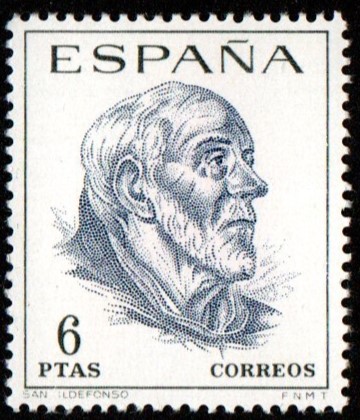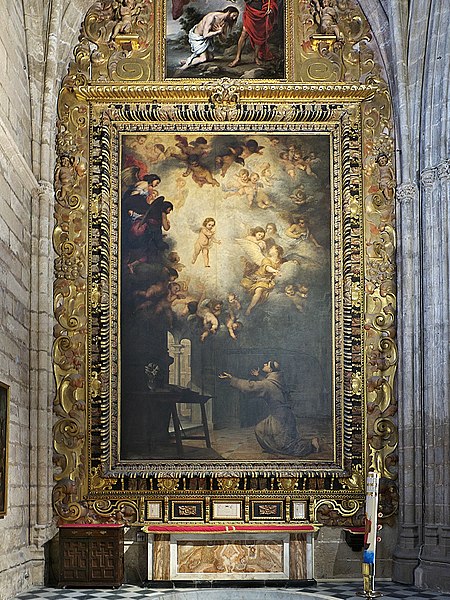San Ildefonso (Saint Ildephonsus) was an influential bishop and theologian who lived in the 7th and 8th centuries. He is best known for his tenure as the Archbishop of Toledo and for his devotion to the Virgin Mary. Here’s a detailed overview:

Early Life and Education: Ildefonso was born around 607 in Toledo, Spain, which was then part of the Visigothic Kingdom. He hailed from a noble family. From an early age, he was inclined towards religious studies. He was educated in Toledo’s cathedral school, where he was taught by Saint Isidore of Seville, a prominent scholar and theologian of that time.
Monastic Life: Following his education, Ildefonso entered the monastery of Agali, located on the outskirts of Toledo. Here, he led a life of asceticism, dedicating himself to prayer, study, and writing.
Archbishop of Toledo: Ildefonso was elected the Archbishop of Toledo in 657, succeeding his uncle, Eugene II. As the archbishop, he was instrumental in promoting orthodoxy and opposing heretical views, particularly those related to Christology.
Writings and Contributions: One of the most significant works attributed to him is “De Virginitate Perpetua Sanctae Mariae,” which defended the perpetual virginity of Mary. This work, along with his other writings, showcased his deep devotion to the Virgin Mary.
Miraculous Event: A famous legend associated with San Ildefonso recounts a miraculous event where the Virgin Mary appeared to him. As per the legend, while Ildefonso was in the church, the Virgin Mary descended from the heavens and presented him with a chasuble (a liturgical vestment) as a token of appreciation for his defense of her perpetual virginity. This event has been depicted in various art forms over the centuries.
Death and Veneration: San Ildefonso passed away on January 23, 667. He was buried in the Visigothic basilica that stood on the site of the current cathedral in Toledo. Over the years, his veneration grew, and he was canonized as a saint by the Catholic Church. His feast day is celebrated on January 23.
Legacy: San Ildefonso’s legacy as a theologian, writer, and archbishop has endured over the centuries. His devotion to the Virgin Mary, his efforts to promote orthodoxy, and his leadership of the Church in Toledo during a critical period have cemented his place as one of the pivotal figures in the history of the Spanish church.
Paintings:
- “The Vision of Saint Ildefonso” by Bartolomé Esteban Murillo: A renowned painting that depicts the miraculous event where the Virgin Mary is said to have appeared to San Ildefonso and presented him with a chasuble. Murillo, a prominent Spanish Baroque painter, captured this event with his characteristic luminosity and tender religious sentiment.
- “The Apparition of the Virgin to Saint Ildefonso” by Juan Carreño de Miranda: Another depiction of the same miraculous event, this painting is a testament to the story’s popularity and significance in Spanish religious art.
- Various other artists, particularly from the Spanish Baroque period, have portrayed San Ildefonso in their works, given his importance in the religious history of Spain and his deep devotion to the Virgin Mary.

El Greco painted several portraits of San Ildefonso, and one of the most notable ones is located in Illescas, a town not far from Toledo.
San Ildefonso (El Greco, Illescas)

- Description: This painting, created by El Greco for the Church of Saint Mary in Illescas, depicts San Ildefonso in episcopal attire, holding a book (likely representing the Gospel or his writings). The portrayal showcases El Greco’s characteristic style, with elongated figures, intense colors, and deep spiritual emotion.
- Historical Context: El Greco was commissioned in the late 16th century to create a series of paintings for the main altar of the Church of Saint Mary in Illescas. The series included not only the portrait of San Ildefonso but also other works such as “The Assumption of the Virgin” and “The Nativity.” San Ildefonso was particularly venerated in the region due to his historical ties as Archbishop of Toledo.
- Significance: The painting of San Ildefonso is an important representation of the saint, emphasizing his scholarly and episcopal attributes. El Greco’s unique approach to religious portraiture, blending Byzantine and Western Renaissance influences, is evident in this work.
- Current Location: The painting remains in the Church of Saint Mary in Illescas, serving as a testament to the town’s religious heritage and El Greco’s enduring influence on Spanish art.
Additional Literature:
- “The Lives of the Fathers, Martyrs, and Other Principal Saints” by Alban Butler.
- Year of Issue: Originally published in 1756-1759
- Publisher: Various editions available
- Note: This multi-volume work includes hagiographies of various saints, including San Ildefonso.
- “The Book of Saints: A Comprehensive Biographical Dictionary” by Basil Watkins.
- Year of Issue: Various editions, latest might be post-2015.
- Publisher: Bloomsbury Publishing
- Note: This dictionary provides concise entries on various saints.
- “Medieval Iberia: An Encyclopedia” edited by E. Michael Gerli.
- Year of Issue: 2003
- Publisher: Routledge
- Note: This encyclopedia covers various aspects of medieval Spain, including religious figures like San Ildefonso.

